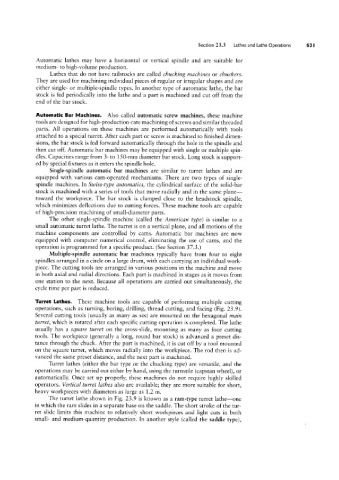Page 650 - Manufacturing Engineering and Technology - Kalpakjian, Serope : Schmid, Steven R.
P. 650
Section 23.3 Lathes and Lathe Operations
Automatic lathes may have a horizontal or vertical spindle and are suitable for
medium- to high-volume production.
Lathes that do not have tailstocks are called chucking machines or c/Quakers.
They are used for machining individual pieces of regular or irregular shapes and are
either single- or multiple-spindle types. In another type of automatic lathe, the bar
stock is fed periodically into the lathe and a part is machined and cut off from the
end of the bar stock.
Automatic Bar Machines. Also called automatic screw machines, these machine
tools are designed for high-production-rate machining of screws and similar threaded
parts. All operations on these machines are performed automatically with tools
attached to a special turret. After each part or screw is machined to finished dimen-
sions, the bar stock is fed forward automatically through the hole in the spindle and
then cut off. Automatic bar machines may be equipped with single or multiple spin-
dles. Capacities range from 3- to 150-mm diameter bar stock. Long stock is support-
ed by special fixtures as it enters the spindle hole.
Single-spindle automatic bar machines are similar to turret lathes and are
equipped with various cam-operated mechanisms. There are two types of single-
spindle machines. In Su/iss-type autoirzatics, the cylindrical surface of the solid-bar
stock is machined with a series of tools that move radially and in the same plane-
toward the workpiece. The bar stock is clamped close to the headstock spindle,
which minimizes deflections due to cutting forces. These machine tools are capable
of high-precision machining of small-diameter parts.
The other single-spindle machine (called the American type) is similar to a
small automatic turret lathe. The turret is on a vertical plane, and all motions of the
machine components are controlled by cams. Automatic bar machines are now
equipped with computer numerical control, eliminating the use of cams, and the
operation is programmed for a specific product. (See Section 37.3.)
Multiple-spindle automatic bar machines typically have from four to eight
spindles arranged in a circle on a large drum, with each carrying an individual work-
piece. The cutting tools are arranged in various positions in the machine and move
in both axial and radial directions. Each part is machined in stages as it moves from
one station to the next. Because all operations are carried out simultaneously, the
cycle time per part is reduced.
Turret Lathes. These machine tools are capable of performing multiple cutting
operations, such as turning, boring, drilling, thread cutting, and facing (Fig. 23.9).
Several cutting tools (usually as many as six) are mounted on the hexagonal main
turret, which is rotated after each specific cutting operation is completed. The lathe
usually has a square turret on the cross-slide, mounting as many as four cutting
tools. The workpiece (generally a long, round bar stock) is advanced a preset dis-
tance through the chuck. After the part is machined, it is cut off by a tool mounted
on the square turret, which moves radially into the workpiece. The rod then is ad-
vanced the same preset distance, and the next part is machined.
Turret lathes (either the bar type or the chucking type) are versatile, and the
operations may be carried out either by hand, using the turnstile (capstan wheel), or
automatically. Once set up properly, these machines do not require highly skilled
operators. Vertical turret lat/aes also are available; they are more suitable for short,
heavy workpieces with diameters as large as 1.2 m.
The turret lathe shown in Fig. 23.9 is known as a ram-type turret lathe-one
in which the ram slides in a separate base on the saddle. The short stroke of the tur-
ret slide limits this machine to relatively short workpieces and light cuts in both
small- and medium-quantity production. In another style (called the saddle type),

